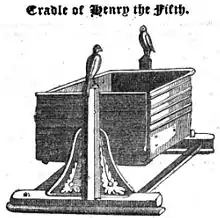Cradle of Henry V
The cradle of Henry V in the Royal Collection is, according to tradition, the cradle in which the newborn Henry of Monmouth, later to be King Henry V of England, was placed. The cradle was bought at auction in 1908 by King Edward VII, and was later loaned to the London Museum by George V. The cradle was on display in the London Museum and its successor the Museum of London until 2005, when it was returned to the Royal Collection. It is now believed to date from a century later than the time of Henry V, but is still considered to be a unique example of a medieval cradle made for a baby of noble birth.
| Cradle of Henry V | |
|---|---|
 The cradle of Henry V photographed by William Edward Gray when it was loaned to the London Museum in 1912 | |
| Material | Oak |
| Present location | Royal Collection |
Description
The cradle is 120 cm (46 inches) long and 86 cm (34 inches) high overall. It is made of oak, and consists of two parts, a deep box-like crib in which the baby was placed and a stand on which the crib swings from iron hooks. The crib is made of planks with a series of deep horizontal mouldings on the exterior. The stand consists of two inverted T-shaped supports with triangular decorated buttresses, and is decorated with carved figures of two heraldic birds watching over the suspended crib. It is now believed to date from the late 15th century, and is a unique example of a medieval cradle made for a baby of noble birth.[1]
History
The cradle is first recorded in 1773, when it was in the possession of the Revd Peregrine Ball, at the Rectory in Newland, Gloucestershire.[2] It was already reputed to have been the cradle of the baby Henry of Monmouth, who was to become King Henry V of England. Henry was born at Monmouth Castle on 16 September 1386. He was the son of Mary de Bohun and Henry Bolingbroke, and the grandson of John of Gaunt.[3] It was said that baby Henry had been put out to nurse at Courtfield, a manor house at Welsh Bicknor, not far from Newland, where an ancestor of the Revd Ball had been a "rocker" to the noble baby and had received the cradle as a perquisite. During the 18th and early 19th centuries the cradle remained at Newland. It was famous locally and was often shown to visitors. Its claim to be a genuine relic of Henry V's childhood was generally accepted.[4]

In 1839 it was in the possession of the antiquarian George Weare Braikenridge, of Brislington, Bristol, who was reported to have bought it for £30.[5][6]
Through confusion with another cradle, this cradle was later said to be at Troy House in Mitchel Troy, Monmouthshire, together with the armour that Henry V wore at Agincourt.[7][8]
The cradle was auctioned at Christie's in London in 1908 and was bought for 230 guineas by Guy Laking, King Edward VII's armourer, bidding on behalf of the King himself.[9] The cradle then went to Windsor Castle and remained there for four years. In 1912 the London Museum was established at Kensington Palace under Guy Laking's direction, and the cradle was loaned to the museum by Edward VII's successor, King George V.[10] The cradle was on display in the London Museum and its successor the Museum of London until 2005, when it was returned to the Royal Collection.[11]
References
- Eames, Penelope (1977). Furniture in England, France and the Netherlands from the Twelfth to the Fifteenth Century. Furniture History Society. pp. 104–7. Retrieved 6 February 2021.
- Bonnor, T. (1798). Bonnor's Copper Plate Perspective Itinerary or Pocket Portfolio,. London. pp. 34–5.
- Biography of HENRY V - Archontology.org. Retrieved 29-3-2012
- "Cradle of Henry V". Mirror of Literature. 5 (121): 9. 1 January 1825.
- Craik, George L. (1839). The pictorial history of England: being a history of the people as well a history of the kingdom: p.238. Knight & Co.
- Magpie's nest of antiquities catches city before cameras, ThisIsBath.co.uk, 19 October 2010. Accessed 13 April 2012
- Wilson, John Marius (1872). Descriptive Imperial Gazetteer of England and Wales: Entry for MONMOUTH.
- Eames, Penelope (1977). Furniture in England, France and the Netherlands from the Twelfth to the Fifteenth Century. Furniture History Society. p. 106. Retrieved 6 February 2021.
- Wanganui Chronicle (16 April 1908) Text
- Kentucky New Era (4 June 1912) Report and illustration
- "Cradle and stand". Royal Collection Trust. Retrieved 26 January 2021.
Further reading
- William Watkins Old, "Historical Notices of the Cradle of Henry V" in Transactions of the Royal Historical Society vol. 4 (1876) pp. 231–259
- Aymer Vallance, "Early Furniture, XV: Cradles and Beds" in Burlington Magazine vol. 24 (1914) pp. 288–289, 292-293